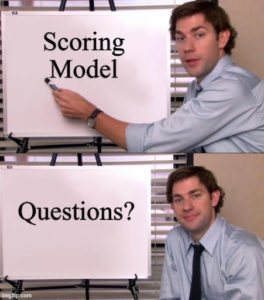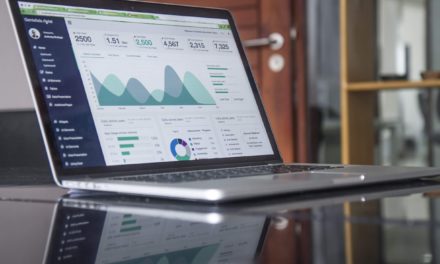Let’s imagine your sales team is completely overwhelmed with marketing qualified leads. They’ve asked you multiple times to stop all marketing, to take a sabbatical and learn soap making or basket weaving. But your manager just sent an email with an idea for a new campaign. What now?
Back before fancy technology like machine learning, traditional lead scoring was the main solution for scenarios like these. For some time, I avoided exploring predictive lead scoring altogether, unsure of what to make of artificial intelligence in my work.
But as usual, getting to know the thing better reduced my fears. I was able to understand predictive scoring, identify its limitations and uncover ways in which it can support B2B lead generation. And now, I shall share my knowledge with you.
What is predictive lead scoring?
Predictive lead scoring uses historical marketing automation and CRM data to predict the likelihood of a lead becoming a customer, through machine learning. And that means that as more leads become customers, predictive scores improve.
That’s because the software has more data to analyze when mapping patterns that typically lead to sales. (The factors used in the predictive scoring can differ between platforms. It seems like Pardot focuses more on behavior/engagement, and HubSpot weighs a wider array of data points.)
The predictive score may be a number on a zero to 100 scale (Pardot) or a percentage (HubSpot). You can use predictive lead scoring for many of the same lead management scenarios as traditional lead scoring.
Who can use predictive scoring?
Some marketing automation providers reserve predictive scoring for their higher-tier editions (surprise, surprise). In HubSpot, it’s only available for Enterprise. Folks using Pardot can get predictive lead scoring with the Advanced edition combined with Salesforce Enterprise, Performance or Unlimited. Connected Campaigns are also a prerequisite in Pardot.
Another thing to consider is the size of your database. HubSpot sets a minimum of 100 contacts to even use this tool, and the more contacts you have, the better. The accuracy of your predictive scores relate to the amount of data available. A larger number of leads and customers allows for a better analysis of your ideal customer profile.
How can you use predictive scoring?
Predictive scoring can help the sales team prioritize lead follow-up to the leads most likely to convert to customers. Not bad. So how can you build predictive lead scoring into your process to make this a reality? And does traditional scoring still play a role?
One simple way to use predictive scoring is by manually checking the scores on lead records. Sales reps can check for high-scoring leads by clicking into their records. That works, but let’s be honest – it’s not the most seamless approach.
Going a layer deeper, you can create lists based on predictive scores, grouping leads whose scores exceed a certain value. When Kimara from sales logs into the CRM, she can toggle between a high scoring marketing qualified (MQL) list and a mid-range MQL list.
Predictive lead scoring can also fit into your MQL criteria. You can incorporate the predictive score into a workflow set up to progress leads to MQL status (i.e., Traditional lead score is 30 or Contact Priority is high). Note: Contact Priority is one of the predictive scoring fields in HubSpot.
You could also integrate predictive lead scoring into lead assignments. When a certain score is reached, it could automatically trigger an assignment to sales.
Unlike traditional scoring, predictive lead scoring does not always reflect someone’s engagement with your content. A high predictive score could be awarded based on a lead downloading a high-value content piece or the fact that they’re coming from an ideal company.
What about traditional scoring?
You may have invested many hours into building a traditional lead scoring model that fits your content and audience. You endured painstaking meetings with the sales team, explaining your rationale and making adjustments based on their feedback. And now, some machine learning software bursts on the scene and throws everything off.
In my view, there can be a place for both. And for those of you who don’t have the highest tiered marketing automation edition or a huge database, traditional scoring is your only option.
But traditional and predictive scores can be leveraged together. Traditional scores indicate a person’s level of interest, while predictive scores make, well, a prediction regarding their likelihood of becoming a customer.
For example, you could use traditional scores in your lead assignment criteria and predictive scores in your nurture campaigns. Since traditional scores reflect actual engagement with your content, they may be a more reliable indicator of someone’s readiness to talk to sales.
Predictive lead scoring is only partly based on engagement. A high score could be generated based on someone downloading the ebook that 90% of your customers downloaded before paying their first invoice. But that may be their only sign of interest. You might send your audience with high predictive scores more bottom-of-the-funnel content to help turn the prediction into a reality.
Is predictive scoring the right option for you?
Traditional scoring can be a meaningful measure of interest. (And it’s cost-effective.) That may be all you need, especially for a smaller volume of leads. With a much larger database, there will be more data points for the machine to analyze and, potentially, a greater need to provide more support to a sales team that’s drowning in contacts.
To me, this really ties to the volume of leads that you need to assign to sales on a day-to-day basis. So before you decide, ask yourself: Are they pressing you for that marketing sabbatical?












